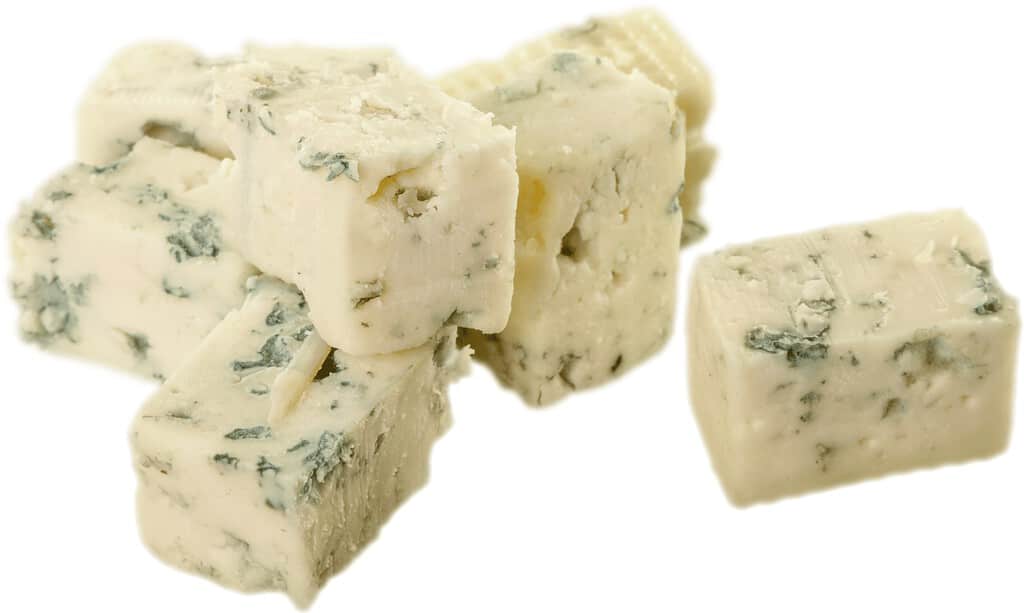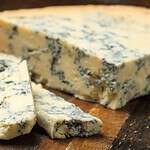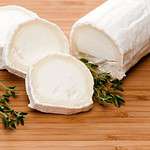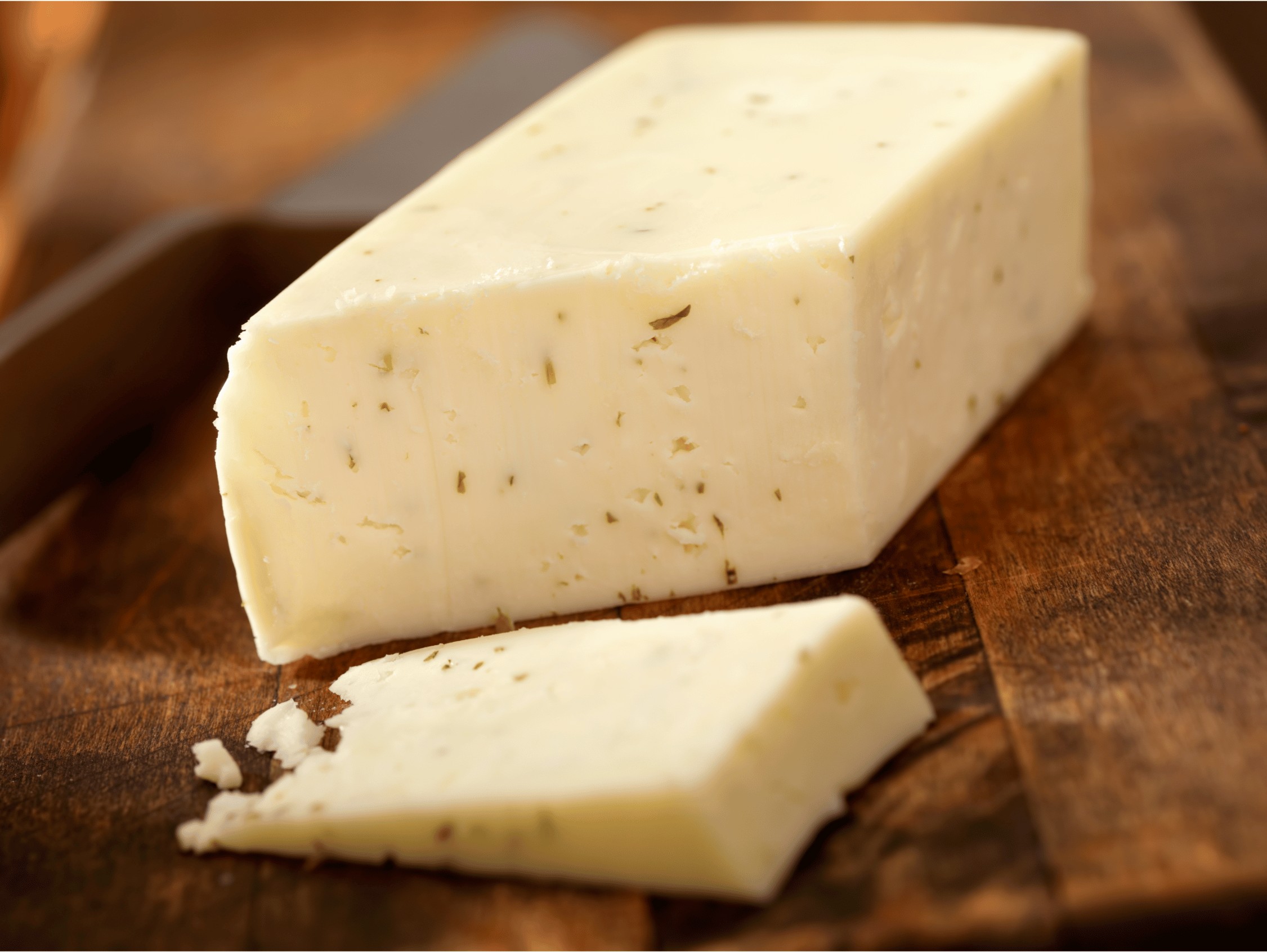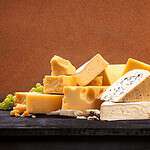Gorgonzola cheese is a distinctive blue-veined cheese originating from Italy, renowned for its strong flavor and creamy texture. Characterized by its blue or green mold, this cheese offers a taste profile that ranges from mild to sharp, largely depending on its age. Gorgonzola can be categorized into two types: Gorgonzola Dolce, which is sweet and soft, and Gorgonzola Piccante, also known as Gorgonzola Naturale, which is more mature and crumbly.

Traditionally made from unskimmed cow’s milk, the production process of Gorgonzola involves the introduction of specific strains of bacteria along with mold spores such as Penicillium glaucum. This initiates the process of aging, which can take place over several months. Throughout this period, the cheese develops its characteristic veining and unique flavors. While Gorgonzola has a noted place in Italian culinary tradition, it is also widely used in various cuisines, often melted into risottos, paired with wines, and used to enhance the flavor profile of sauces and salads.
Key Takeaways
- Gorgonzola is a blue-veined Italian cheese known for its robust flavor and creamy to crumbly texture.
- It is produced using particular strains of bacteria and mold, with aging contributing to its unique taste.
- Gorgonzola is versatile in cooking, frequently used in Italian dishes, paired with wines, and added to sauces or salads.
What Is Gorgonzola Cheese
Gorgonzola cheese is a distinctive blue cheese originating from Italy, renowned for its unique texture and flavor profile. We’ll examine its origins, characteristics, differences from other blue cheeses, and its nutritional makeup.
Definition and Origin
Gorgonzola is a type of blue cheese that hails from the northern regions of Italy, specifically Lombardy and Piedmont. Its history dates back to the 11th century, making it one of the world’s oldest blue-veined cheeses. Traditionally, it is made from unskimmed cow’s milk and is later injected with Penicillium glaucum mold to achieve the characteristic blue veining.
Characteristics and Varieties
This cheese is known for its creamy texture and sharp flavor. There are primarily two types of Gorgonzola: Gorgonzola Dolce (sweet Gorgonzola) and Gorgonzola Piccante (Gorgonzola Naturale or mountain Gorgonzola). Gorgonzola Dolce is softer and has a milder taste, while Gorgonzola Piccante is firmer, crumblier, and has a more assertive flavor.
- Gorgonzola Dolce: Creamy, mild, with a hint of sweetness.
- Gorgonzola Piccante: Also known as Gorgonzola Naturale or Mountain Gorgonzola, it is aged longer and has a robust, spicy profile.
Gorgonzola vs. Other Blue Cheeses
Gorgonzola distinguishes itself from other blue-veined cheeses like Roquefort and Stilton through its subtler and less salty flavor compared to Roquefort, and a creamier texture than the firmer Stilton. These cheeses also differ in the types of molds used and their regions of origin, with Roquefort coming from France and Stilton from England.
Nutritional Profile
Gorgonzola, like most blue cheeses, is rich in nutrients. A typical serving contains a significant amount of protein and fat content. It also contains calories and sodium, which should be considered when adding it to your diet.
- Calories: Approximately 100 kcal per 1-ounce serving.
- Protein: 6 grams per serving.
- Fat: About 8-9 grams per serving, with saturated fat constituting a major part.
- Sodium: Can vary, but generally high due to the cheese’s salty flavor profile.
Understanding the origin, varieties, comparison with other cheeses, and the nutritional profile helps us appreciate Gorgonzola’s unique place in the cheese world.
Production of Gorgonzola Cheese
We will guide you through the specific steps and conditions that are critical in the production of Gorgonzola cheese, focusing on the cheesemaking process, aging, and the role of unique cultures and molds.
Cheesemaking Process
We begin with the selection of high-quality milk, which is then pasteurized to ensure safety and consistency. The milk is inoculated with specific strains of bacteria and rennet is added to coagulate the milk into curds and whey. These curds are then cut, allowing whey to be released. The separated curds form the basis of Gorgonzola cheese.
Aging and Maturation
Once formed, the cheese is salted and then transferred to an aging facility where it undergoes a precise aging process. This takes place in conditions with controlled humidity and oxygen levels that support the development of the cheese’s characteristic flavors and textures. Typically, Gorgonzola is aged for about three to four months.
Cultures and Molds
During the aging phase, Penicillium roqueforti or Penicillium glaucum spores are introduced to the cheese. These molds are responsible for Gorgonzola’s distinctive blue veining. The molds interact with the cheese as it matures, creating not only the veins but also contributing to the creamy texture and sharp, tangy flavor Gorgonzola is renowned for.
Culinary Uses and Pairings

Gorgonzola cheese’s versatility allows us to incorporate its distinct flavor into a variety of dishes, enhancing them whether served on a cheese board or melted into a recipe. We’ll explore the traditional and modern uses of this cheese, its harmony with wines, and the best ways to serve and present it at the table.
Traditional and Modern Recipes
Gorgonzola serves as a pivotal ingredient in Italian cuisine, offering creamy or piquant notes to various dishes. We find it mainly used in:
- Pizzas: Often dotted atop a pizza for a tangy contrast.
- Risottos: Incorporated for a creamy consistency and bold flavor.
- Pastas: Mixed into sauces or crumbled over the top for a flavor boost.
In modern recipes, chefs have expanded its use, for example:
- Salads: Gorgonzola pairs beautifully with walnuts and vinaigrettes.
- Cooking Sauces: Used to enhance the flavor profile of a sauce.
Wine and Food Pairings
When pairing gorgonzola with wine, balance is key as the right wine can either complement or contrast its rich profile.
- Red Wine: A full-bodied Zinfandel can stand up to gorgonzola’s strong flavors.
- Sweet Wine: Sauternes or a similar sweet wine contrasts the saltiness of the cheese perfectly.
Here’s a pairing guide to follow:
| Cheese Style | Wine Pairing | Pairing Notes |
|---|---|---|
| Creamy | Sauternes, Sweet Dessert Wine | Sweetness balances creamy gorgonzola. |
| Piquant | Robust Zinfandel | A bold choice that complements the spice |
Serving and Presentation
For an appealing cheese board, we often:
- Slice or crumble gorgonzola.
- Serve alongside nuts, particularly walnuts.
- Add honey for a touch of sweetness.
It’s essential to present the cheese at its best:
- Parchment Paper: Preferable for serving as it’s non-stick and resistant to grease.
- Wax Paper: A suitable alternative for wrapping and short-term storage.
Take note of the temperature too, as serving gorgonzola at room temperature maximizes its flavor and texture.
Gorgonzola in Italian Culture

In Italy, Gorgonzola cheese is a revered traditional product from Northern Italy with a rich history, esteemed for its Protected Designation of Origin status. It holds a significant place in our culinary landscape, especially in dishes that are cherished across the region.
Historical Significance
Gorgonzola cheese has been produced in Northern Italy since the late Middle Ages, making it one of the oldest blue cheeses in the world. It is named after the town of Gorgonzola, near Milan, where the cheese was reportedly first created in the 12th century. Over the centuries, our methods of production have evolved, but the cheese remains a symbol of our artisanal heritage and regional pride.
Protected Designation of Origin (PDO)
Since 1996, Gorgonzola has been recognized as a PDO product under European Union law. This status ensures that only cheese produced within certain provinces in the regions of Piedmont and Lombardy, under strict guidelines, can be called Gorgonzola. This designation serves to protect the cheese’s traditional production methods and the regional environment integral to its unique flavor.
- Provinces with PDO status for Gorgonzola:
- In Piedmont: Novara, Verbano-Cusio-Ossola, Vercelli, and the territory of Casale Monferrato.
- In Lombardy: Bergamo, Brescia, Como, Cremona, Lecco, Lodi, Milano, Monza, Pavia, and Varese.
Gorgonzola in Italian Dishes
Gorgonzola is a staple in our Italian kitchens, where it imparts its creamy and robust flavor to a variety of dishes. It is often found in risottos, lending a rich and tangy taste that complements the creamy rice. Our chefs also use it in polenta recipes for a comforting meal, and it finds its way into myriad pastas, both as a main ingredient and as part of a sauce. The cheese also adds complexity to fillings and toppings, enhancing the overall taste experience.
- Examples of Italian dishes with Gorgonzola:
- Risotto al Gorgonzola: Creamy risotto with a rich Gorgonzola sauce.
- Polenta con Gorgonzola: Warm polenta with melted Gorgonzola cheese.
- Pasta con Gorgonzola: Various pasta types combined with creamy Gorgonzola sauce.
Gorgonzola cheese remains an essential component of our cultural heritage and our culinary traditions in Italy. Through its historical roots, protected status, and place in our nation’s cuisine, it is a testament to the confluence of time-honored practices and our contemporary Italian way of life.
Storing and Handling

Proper storage and handling are crucial for maintaining the quality and extending the shelf life of Gorgonzola cheese. Let’s go through the best practices to store Gorgonzola and how to cut and serve it for the best experience.
Best Storage Practices
Gorgonzola cheese should ideally be stored in the refrigerator, preferably at a temperature between 35°F and 40°F. Use the following table as a quick reference for best storage practices:
| Storage Location | Condition | Duration |
|---|---|---|
| Refrigerator | Original packaging | Until the ‘Use By’ date |
| Refrigerator | Wrapped in foil or plastic wrap | 3-4 weeks after opening |
To ensure optimal quality:
- Wrap the cheese in wax paper, parchment paper, or aluminum foil after each use, since this allows the cheese to breathe and reduces the risk of it absorbing other flavors from the refrigerator.
- Avoid airtight containers unless they are specifically designed for cheese storage, as Gorgonzola needs a certain amount of airflow.
- Place the wrapped cheese in the crisper drawer of your refrigerator where the temperature is more consistent.
- Check periodically for any signs of spoilage, such as an off smell or excessive mold growth beyond the typical marbling of blue.
Tips for Cutting and Serving
When ready to serve, remove the Gorgonzola from the refrigerator and allow it to come to room temperature for about 30 minutes; this enhances the cheese’s flavor and texture. Consider the following tips for cutting and serving:
- Use a clean cheese knife to avoid cross-contamination with other flavors.
- Cut into small wedges or cubes to make it easier for guests to enjoy.
- Serve on a wooden or ceramic cheese board to maintain the cheese’s temperature longer while serving.
Remember, once cut, Gorgonzola’s exposed areas can dry out, so cover any leftovers and store them as advised above.
Health and Dietary Information

Gorgonzola cheese offers various health benefits but also requires consideration for those with dietary restrictions. We’ll examine the nutritional advantages as well as provide guidance for those who cannot consume this cheese.
Health Benefits and Considerations
Gorgonzola cheese is a source of several important nutrients. Specifically, it contains:
- Proteins: Essential for muscle repair and growth.
- Calcium: Vital for bone health.
However, it’s high in:
- Saturated fat: Can contribute to heart disease if consumed in excess.
- Sodium: High intake can lead to hypertension.
People with a sensitivity to mold or penicillin should avoid gorgonzola, as it is a blue cheese containing Penicillium glaucum.
Dietary Restrictions and Substitutes
For vegetarians, it’s important to note that gorgonzola often contains animal rennet, which makes it unsuitable for strict vegetarian diets. We recommend checking the label or contacting the manufacturer to confirm its suitability.
For those looking for substitutes due to health reasons or dietary choices, we suggest:
- Vegan Blue Cheese: Made from plant-based ingredients, often including soy or nuts.
- Feta Cheese: Often considered for its similar crumbly texture, although it lacks the distinct blue veins.
Keep in mind that substitutes may vary in taste and texture, but can provide a suitable alternative for those unable to consume traditional gorgonzola.
Frequently Asked Questions
In this section, we cover some of the most common inquiries about Gorgonzola cheese to give you a clearer understanding of its unique characteristics.
How does Gorgonzola cheese taste compared to other cheeses?
Gorgonzola has a distinct taste that is often described as sharp and salty with a bit of a bite from the blue veining. Compared to milder cheeses like Brie, Gorgonzola is robust, and next to sharper cheeses like Cheddar, it has a creamier texture with a tangy aftertaste.
What distinguishes Gorgonzola from Roquefort and Stilton cheeses?
Gorgonzola, Roquefort, and Stilton are all blue cheeses but they differ in origin and ingredients. Gorgonzola is Italian and made from cow’s milk, Roquefort is French and made from sheep’s milk, and Stilton is English and can only be made in specific counties in England. Each has a unique taste due to these differences.
Are there different varieties of Gorgonzola cheese, and if so, what are they?
Yes, there are two main types of Gorgonzola cheese: Gorgonzola Dolce, which is soft and spreadable with a mild flavor, and Gorgonzola Piccante (also known as Gorgonzola Naturale or Mountain), which has a firmer texture and a more pronounced flavor.
How should Gorgonzola cheese be pronounced correctly?
Gorgonzola is pronounced as gor-guhn-ZOH-luh. The emphasis is on the third syllable, with a silent ‘g’ following the ‘n’.
Can you describe how to make a sauce with Gorgonzola cheese?
To make a Gorgonzola sauce, melt the cheese into a base of cream or milk over low heat, stirring until smooth. Season with salt, pepper, and sometimes mustard or herbs for added flavor. This sauce pairs well with pasta, meats, and vegetables.
What are the nutritional benefits or downsides of consuming Gorgonzola cheese?
Gorgonzola cheese is rich in calcium and protein, which are beneficial for bone and muscle health. However, it is also high in saturated fat and sodium, which should be consumed in moderation, especially by those watching their cholesterol and blood pressure.

